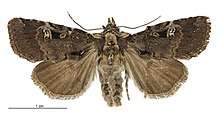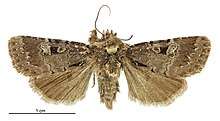Austramathes pessota
Austramathes pessota is a species of moth in the family Noctuidae.[1] It is endemic to New Zealand.[2]
| Austramathes pessota | |
|---|---|
 | |
| Female | |
 | |
| Male | |
| Scientific classification | |
| Kingdom: | Animalia |
| Phylum: | Arthropoda |
| Class: | Insecta |
| Order: | Lepidoptera |
| Superfamily: | Noctuoidea |
| Family: | Noctuidae |
| Genus: | Austramathes |
| Species: | A. pessota |
| Binomial name | |
| Austramathes pessota (Meyrick, 1887) | |
| Synonyms | |
| |
Taxonomy
A. pessota was first described by Edward Meyrick in 1887 under the name Miselia pessota.[3] In 1906 this species was tentatively placed in the genus Sympistis by George Hampson.[4] Meyrick, in 1911, disagreed with this placement but somewhat doubtfully suggested placing the species in the genus Hypnotype.[5] Meyrick again reconsidered the taxonomy of this species in 1914 and placed it within the genus Andesia.[6] Robert J. B. Hoare studied the species and placed it within the genus Austramathes in 2017.[1]
Description
George Hudson described the species as follows:
The expansion of the wings is 1 inch. The fore-wings are dull purplish-brown; there is an oblong black mark at the base of the dorsum containing a slender curved white line; the orbicular is rather small, round, margined first with dull white and then with black; the reniform is large, oblong, dull white, margined with pale ochreous towards the base of the wing; there is a conspicuous oblong black mark between the orbicular and reniform stigmata. The hind-wings are dull grey, with the cilia paler.[7]
Distribution
A. pessota can be found in Northland, in the southern North Island and in the South Island, mainly on the eastern side that island.[1]
Host species
Larvae of this species feed on Melicytus alpinus and Hoare states it is likely that Melicytus micranthus is also a host.[1]
References
| Wikimedia Commons has media related to Austramathes pessota. |
- Hoare, R.J.B. (23 June 2017). "Noctuinae (Insecta: Lepidoptera: Noctuidae). Part 1, Austramathes, Cosmodes, Proteuxoa, Physetica" (PDF). Fauna of New Zealand. 73: 1–130. doi:10.7931/J2/FNZ.73.
- "Austramathes pessota (Meyrick, 1887)". www.nzor.org.nz. Landcare Research New Zealand Ltd. Retrieved 30 March 2018.
- Meyrick, Edward (1887). "Monograph of New Zealand Noctuina". Transactions and Proceedings of the Royal Society of New Zealand. 19: 3–40 – via Biodiversity Heritage Library.
- Hampson, George Francis (1906). "Catalogue of the Noctuidae in the collection of the British Museum". Catalogue of the Lepidoptera Phalaenae in the British museum. 6: 1–532 – via Biodiversity Heritage Library.
- Meyrick, Edward (1912). "A revision of the classification of the New Zealand Caradrinina". Transactions and Proceedings of the Royal Society of New Zealand. 44: 88–107 – via Biodiversity Heritage Library.
- Meyrick, Edward (1914). "Descriptions of New Zealand Lepidoptera". Transactions and Proceedings of the Royal Society of New Zealand. 46: 101–118 – via Biodiversity Heritage Library.
- Hudson, George Vernon (1898). New Zealand moths and butterflies (Macro-lepidoptera). London: West, Newman & co. p. 6. Retrieved 30 March 2018.
![]()